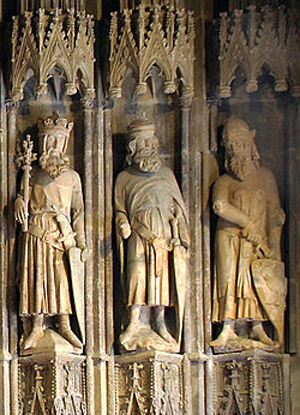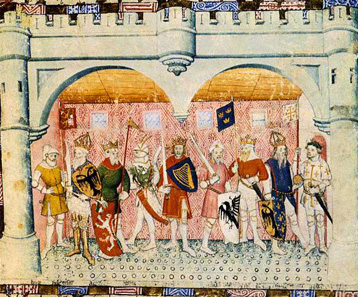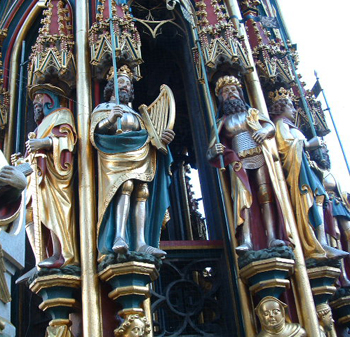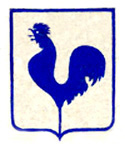 |
Stories & Legends
The Nine Worthies
Hugh O’Reilly
Writing in the early 14th century, Jean de Longuyon presented three triads of warrior heroes as models of chivalry. The Nine Worthies, as they were called, became a common and enduring theme in Western Europe, represented in art works and literature through France, England, Germany, Spain and Italy.
The first triad comes from the Old Law: Joshua, who led the conquest of the Holy Land, King David, the great leader of the Hebrews, and Judas Maccabeus, the warrior who led the fight against the adaptation of the synagogue to the world of the time, represented by the Seleucids.

Arthur, Godfrey and Charlemagne on the Cathedral of Cologne |
The next triad consists of warriors from the Roman or pagan Law: Hector, the brave warrior of Troy, Alexander, the creator of the Hellenic Empire, and the Roman general Julius Caesar.
The third triad refers to the New Law that gave birth to Catholic Civilization, heir of both the Hebrews and Pagans: the legendary King Arthur, Charlemagne who founded the Holy Roman Empire, and the conqueror of the Kingdom of Jerusalem, Godfrey de Bouillon.
The symmetry of the scheme reflects the medieval view of History and destiny of Christendom. The Old Law prepared the way for the New. The Pagan law created the Pax Romana that in some ways favored the spread of the New Law. And the medievals saw themselves as the true heirs of both the Hebrews and the Pagans, and their civilization as the fulfillment of God’s divine plan.
The characters are archetypes – personifying the virtues of chivalry: courtesy, loyalty, prowess, hardiness, largesse, honesty and above all, service to the Church and country. What follows comes from Maurice Keen's classic work Chivalry.
Jean de Longuyon introduces us to the series of three matching triads, which make up the tally of nine supreme heroes in his Voeux du Paon (Vows of the Peacock). There are three champions of chivalry of the Old Law, he says, Joshua, David and Judas; three champions of the pagan law, Hector, Alexander and Julius Caesar; and three champions of the new Christian Law, Arthur, Charlemagne and Godfrey de Bouillon. This is the first appearance in chivalrous literature of the Nine Worthies (or the Neuf Preux).
This conception was a very powerful one. Its symmetry, at once striking and symbolic, lent itself directly to iconographic representation, in painting, sculpture and illumination. Multiple portrayals of these heroes were painted, verses hailing the Worthies were composed, and books recording the history of their high deeds put together. Their associated reputations established rapidly their right to occupy the first circle of the chivalric court of honor.
There was nothing haphazard about Jean de Longuyon's triads: indeed his conception was in no sense really new. Earlier texts often throw a selection of his heroes together as examples of chivalry, and Philip Mouskes, in his mid 13th-century rhyming chronicle, anticipated the idea by representing the three laws with three heroes – his choices were Hector, Judas, and Ogier, the heroic Dane of Carolingian legend. Jean simply introduced a new tidiness and symmetry. But this in itself was impressive. His triads symbolize beautifully the three principal ‘chapters’ in chivalrous history, and clarify thereby its place in the broad framework of Christian providential world History.

The Nine Worthies, illustration from Thomas of Saluzzos' Knights Errant, 15th c. |
The three Jewish heroes remind us that the Old Testament is the story of God's chosen nation, which was the spiritual vessel of His purpose for mankind, and through whose service of the one true God, the way was made ready for the coming of Christ.
Christ's mission, though, was not to the Jews only, and the pagans had a part too in preparing the way for the New Law. Christ came as the Prince of Peace at that point in time when the Romans had conquered the world and established their peace in it. It was the Roman peace, built on the achievement of pagan chivalry – Trojan, Greek, and Roman – that made possible the journeys of the Apostles, their evangelization of the Gentiles, and the establishment of the Catholic Civilization.
This is the strand in chivalrous history that Hector, Alexander and Caesar remind us about, and its story does not stop short with the last of them. It was Vespasian and his Roman knights who, by destroying Jerusalem and the Temple, took vengeance for Christ's death. And with the conversion of Constantine the Roman Empire and Christendom in some ways merged.
Catholic chivalry is thus the fruit of the marriage of those two older traditions, pagan knighthood that God ordained to rule the world and to uphold peace in it, and the biblical knighthood that He ordained to guard the Holy Places and defend the Religion of His Chosen People.
The three Catholic warrior heroes represent the armed force of His new chosen people, the Catholic nations, whose missions derive from the earlier traditions; those being to uphold His Peace, to spread His Law, and to guard His Holy Places.
The juxtaposition of the three biblical champions and the three classical heroes with the principal figures of France and Britain - Charlemagne and King Arthur - thus brings chivalry's role and origin into perspective in world History as understood at the time.

Judas Maccabeus, David, Caesar and Alexander on the fountain in Nuremberg square, Germany |
But there is a third figure in the last triad alongside Charlemagne and Arthur: Godfrey de Bouillon the conqueror of Jerusalem, who played a significant role in the historical events of the First Crusade and its remarkable victories. His place in the company of the Nine Worthies was important for another reason too.
In terms of the early 14th century, when Jean de Longuyon was writing, Godfrey was by far the most recent recruit into the circle of the Nine Worthies. He, more effectively than any of the others, symbolized the fact that the story of chivalry's divine mission in the world was still in process, that that mission was an urgent and contemporary one, and that there was no reason why, with the nine, all the ‘sieges’ of the first circle of chivalrous honor should be regarded as occupied.
The cult of the Nine Worthies thus had a very direct message for the chivalrous world. It is here significant that the cyclic manuscripts of Godfrey's epic history, of the Chevalier au Cygne [Knight of the Swan], do not all stop at the conquest of Jerusalem. In some, an attempt has been made to carry the crusading story on to the middle of the 13th century. As far as the Crusade to Jerusalem was concerned, the story had to stop there: the tale of the collapse of the Crusader Kingdom could hardly produce any more Worthies. Other histories, on the other hand, could.
In France, the great constable Du Guesclin was hailed as the Tenth Worthy. The Scots claimed the same honor for Robert the Bruce. The author of the Chemin de Vaillance [Path of Bravery] threw into the company of the Nine not only a series of other ancient heroes (Hercules, Achilles, Jason, Scipio) but also a little group of great contemporaries, including again Du Guesclin, and alongside him Louis de Sancerre and Hugh Calverley of England.
The Nine Worthies symbolized the significance of a story that was emphatically unconcluded, reminding men at once of the example of the past and that the history of chivalry was still a-making.

The Nine Worthies, a mural from the walls of the Castella della Manta in Saluzzo, Italy |

Slightly adapted from Maurice Keen, Chivalry,
London: Yale University Press, 1984, pp. 121-123
Posted on August 17, 2012


Related Topics of Interest
 Charlemagne Charlemagne
 The Arms of Lorraine & Visconti The Arms of Lorraine & Visconti
 Honor, a Counter-Revolutionary Virtue Honor, a Counter-Revolutionary Virtue
 The Investiture of the Knight The Investiture of the Knight
 The One of the Valiant Deeds The One of the Valiant Deeds
 Courage and Obedience Courage and Obedience
 The Knights of St. James of the Sword The Knights of St. James of the Sword
 The Prayers of a Knight The Prayers of a Knight
 St. Louis IX, Warior and Saint St. Louis IX, Warior and Saint
 Refuting Lies about the Middle Ages Refuting Lies about the Middle Ages

Related Works of Interest
|
|
Legends | Religious | Home | Books | CDs | Search | Contact Us | Donate

© 2002-
Tradition in Action, Inc. All Rights Reserved
|
 |
|